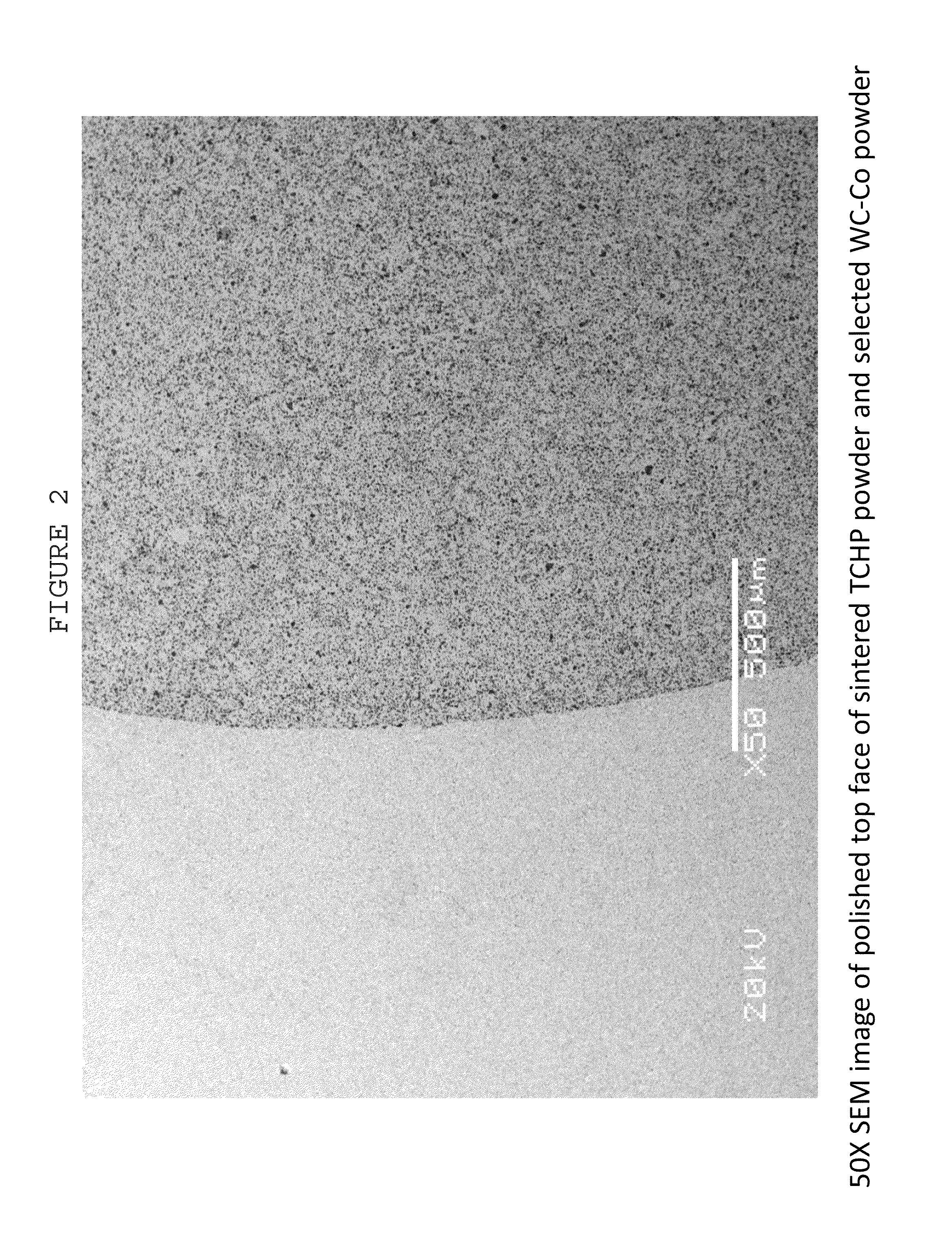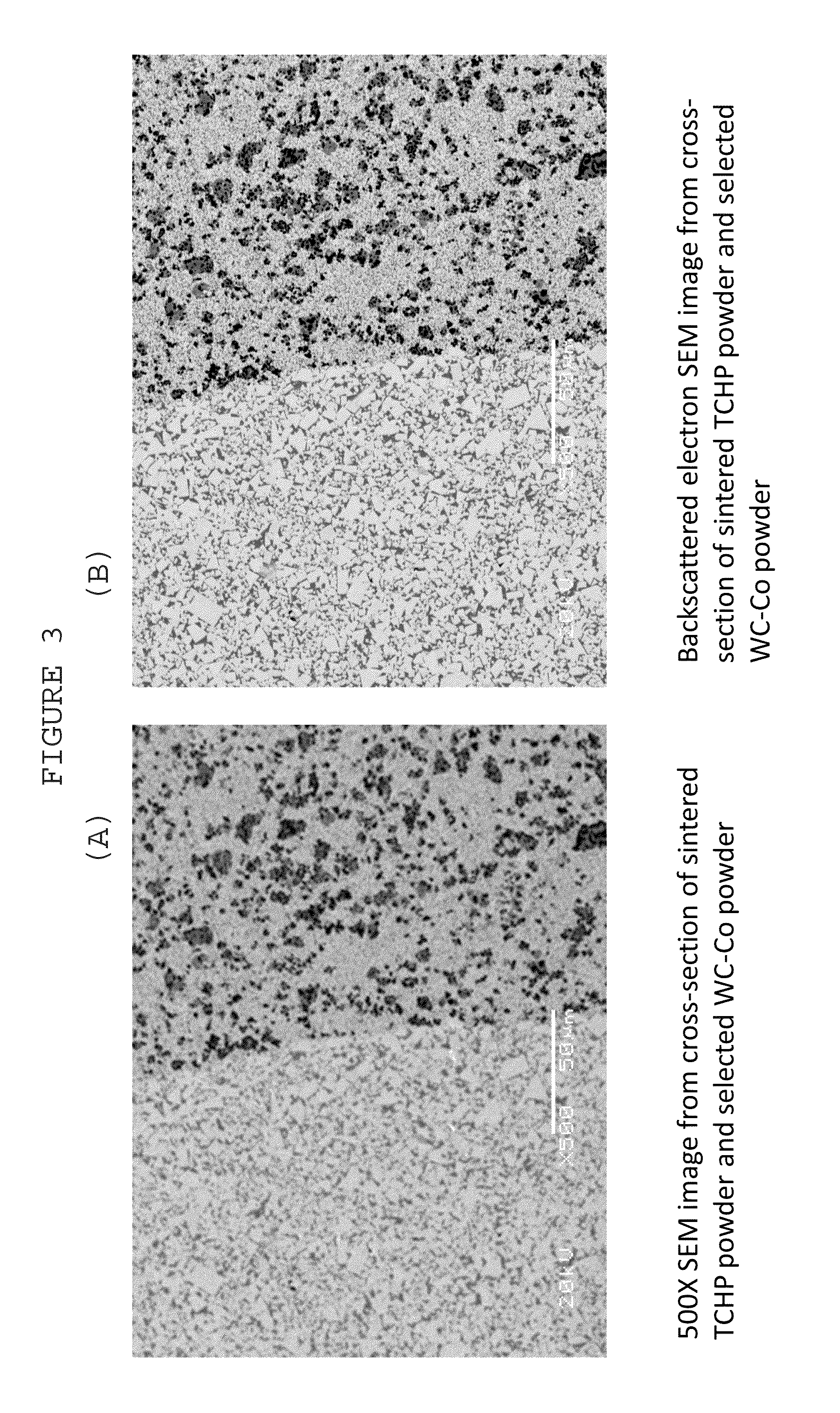Methods of forming a metallic or ceramic article having a novel composition of functionally graded material and articles containing the same
a functional graded material and composition technology, applied in the field of making metallic and ceramic articles, can solve the problems of increasing the cost and lead time of additional processes, limiting the use of special applications, and requiring more process steps
- Summary
- Abstract
- Description
- Claims
- Application Information
AI Technical Summary
Benefits of technology
Problems solved by technology
Method used
Image
Examples
example 1
FGM Solid Rods Having Different Top and Bottom Materials
[0171]Twelve FGM two-material rods were prepared and sinter hot isostatic pressed (HIPed) according to the methods below. The rods were each comprised a top material making up ⅔ of the rod, and a bottom material making up the remaining ⅓ of the rod. Each rod made in this Example was comprised of a TCHP / WC—Co FGM Rod having a ⅜″ OD×2½″. The specific materials used for top and bottom sections were:
[0172]
Top ⅔ MaterialBottom ⅓ MaterialWC-15CoTi(C, N) core TCHP TL-3
[0173]The WC—Co material used in this example comprised 3 micron nominally sized WC with 15 wt % cobalt, and exhibited the following physical properties: Hardness (ASTM B294) of 88.0, an HRA Fracture Toughness (ISO 28079) of 11.49 MPa / m, and a Density (ASTM B311) of 14.05 g / cm3.
[0174]The TL-3 had the following Physical Properties: Hardness (ASTM B294) of 92.1, an HRA Fracture Toughness (ISO 28079) of 11.43 MPa / m, and a Density (ASTM B311) of 12.75 g / cm3.
[0175]The typical...
example 2
FGM Cylinders with Different Inner and Outer Materials
[0189]Four variations of FGM two-material cylinders were prepared and vacuum sintered as described herein, with the following inner and outer materials.
[0190]
SampleInner MaterialOuter MaterialATi(C, N) core TCHP TL-3WC-15Co GWC-50BAl2O3 core TCHP NL-3WC-15Co GWC-50CAl2O3 core TCHP NL-3Ti(C, N) core TCHP TL-3DTi(C, N) core TCHP TL-3Al2O3 core TCHP NL-3
[0191]Typical Powder Pressing Method (for FGM Cylinders)
[0192]The following provides the methodology used for powder pressing FGM Cylinders made according to the present disclosure.
[0193]A thin-walled hollow steel tube (outer diameter 0.340″) was placed into the center of the cylindrical die tooling set (diameter 0.580″) on a conventional powder press to maintain separation during loading of the two distinct powder types (“inner” and “outer” materials).
[0194]Approximately 8 grams of TCHP “inner” powder was placed in the interior of the hollow tube, and approximately 12.5 grams of “ou...
PUM
| Property | Measurement | Unit |
|---|---|---|
| particle size | aaaaa | aaaaa |
| pressure | aaaaa | aaaaa |
| temperature | aaaaa | aaaaa |
Abstract
Description
Claims
Application Information
 Login to View More
Login to View More - R&D
- Intellectual Property
- Life Sciences
- Materials
- Tech Scout
- Unparalleled Data Quality
- Higher Quality Content
- 60% Fewer Hallucinations
Browse by: Latest US Patents, China's latest patents, Technical Efficacy Thesaurus, Application Domain, Technology Topic, Popular Technical Reports.
© 2025 PatSnap. All rights reserved.Legal|Privacy policy|Modern Slavery Act Transparency Statement|Sitemap|About US| Contact US: help@patsnap.com



